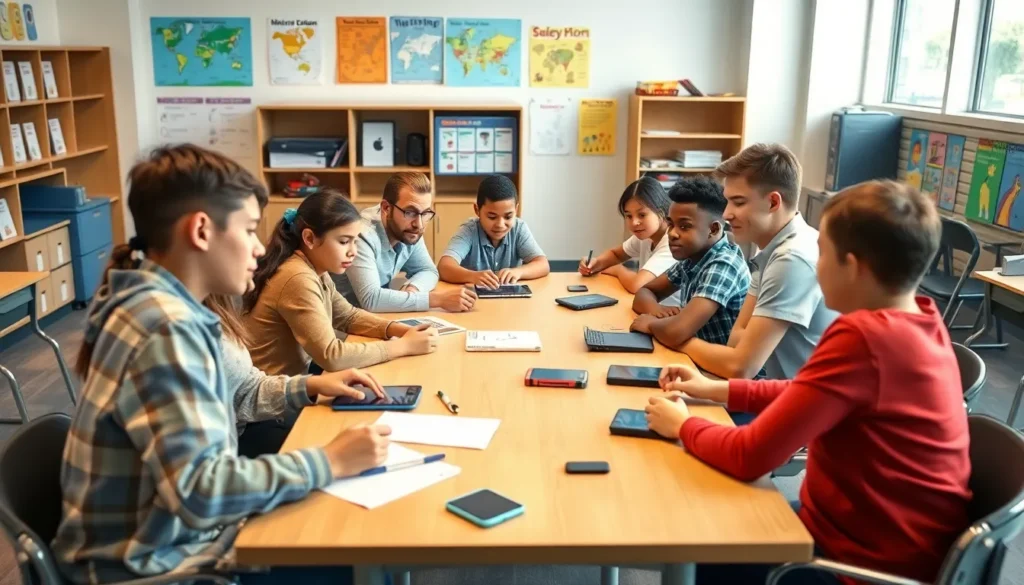Table of Contents
ToggleIn today’s rapidly changing world, the education curriculum plays a crucial role in shaping the future of students. It serves as a roadmap that guides educators in delivering knowledge and skills essential for personal and professional growth. A well-structured curriculum not only enhances learning outcomes but also prepares students to navigate the complexities of modern society.
As educational standards evolve, so do the approaches to curriculum design. Innovative teaching methods and technology integration are transforming traditional learning environments, making education more engaging and relevant. Understanding the intricacies of curriculum development is vital for educators, policymakers, and parents alike, as it directly impacts the quality of education and student success.
Overview of Education Curriculum
Education curriculum encompasses the subjects and content taught within a school program. It functions as a framework guiding educational goals, instructional strategies, and assessment methods. A comprehensive curriculum includes core subjects such as math, science, language arts, and social studies, along with additional areas like the arts, physical education, and vocational training.
Key components of an effective education curriculum include:
- Learning Objectives: Clearly defined goals outline what students are expected to learn within specific time frames.
- Content Selection: Material chosen aligns with both state standards and students’ needs while being relevant and engaging.
- Teaching Methods: Diverse instructional strategies, incorporating direct instruction, collaborative learning, and experiential activities, make learning more effective.
- Assessment Practices: Regular evaluations measure students’ understanding and skills, guiding adjustments to teaching methods and curriculum design.
Regular reviews and updates to the curriculum ensure it remains pertinent in a rapidly changing society. Integration of technology and real-world applications within the curriculum prepares students for future challenges and opportunities. Stakeholders, including educators, parents, and community members, play crucial roles in the curriculum development process, sharing insights and feedback that influence educational quality.
By prioritizing a well-structured education curriculum, schools promote lifelong learning and critical thinking skills, essential for success in the 21st century.
Importance of Education Curriculum

An effective education curriculum holds significant importance in shaping student success and enhancing educational quality. It serves as a framework that guides educators, influences instructional strategies, and fosters students’ academic achievement.
Impact on Student Learning
Curriculum directly impacts student learning by establishing clear learning goals and expectations. Students gain a structured understanding of what they need to learn at each stage. Research shows that students in schools with well-defined curricula exhibit improved performance on standardized assessments. Relevant content selection ensures students engage with materials that relate to their lives, fostering deeper connections to the subject matter. Diverse teaching methods incorporated within the curriculum cater to various learning styles, promoting inclusive education practices.
Role in Teacher Planning
The curriculum plays a crucial role in teacher planning by providing a roadmap for instruction. It outlines essential topics and skills teachers need to cover throughout the academic year. Effective planning requires alignment with learning objectives, allowing educators to develop lesson plans that are both coherent and sequential. Regular curriculum reviews empower teachers to adapt their approaches based on student needs and educational trends. Additionally, a well-structured curriculum fosters collaboration among teachers, enabling them to share resources and best practices that enhance overall educational outcomes.
Types of Education Curriculum
Education curriculum can be categorized into various types, each serving different educational philosophies and needs. Understanding these types aids in the effective design and implementation of educational strategies.
National vs. Local Curriculum
National curriculum refers to standardized educational guidelines established by a governing body, ensuring consistency across schools within a country. This type outlines specific subjects, content standards, and assessment methods.
Local curriculum, on the other hand, enables school districts or individual schools to tailor educational content and techniques to better fit the community’s demographics, culture, and values. Local decisions address unique educational needs, encouraging flexibility and innovation.
| Type | Characteristics |
|---|---|
| National Curriculum | Standardized across schools, consistent assessment practices. |
| Local Curriculum | Customizes educational experience based on local community. |
Subject-Centric vs. Integrated Curriculum
Subject-centric curriculum focuses on individual subjects taught independently, emphasizing content mastery within specific disciplines, such as mathematics or science. This approach allows teachers to delve deeply into subject matter, but may create silos in learning.
Integrated curriculum combines multiple subjects into thematic units, promoting connections between disciplines and enhancing relevance. This method engages students by relating topics to real-world contexts, fostering critical thinking and collaboration skills.
| Curriculum Type | Focus Area |
|---|---|
| Subject-Centric | Mastery of individual subjects, isolated learning. |
| Integrated Curriculum | Interdisciplinary approach, relevance to real-world. |
Current Trends in Education Curriculum
Current trends in education curriculum reflect a shift towards enhancing engagement and relevance in learning environments. Two prominent trends include technology integration and a focus on social-emotional learning.
Technology Integration
Technology integration becomes crucial in modern curricula. Schools employ digital tools like interactive whiteboards, learning management systems, and educational apps. These resources facilitate personalized learning experiences, allowing students to progress at their own pace. The use of virtual simulations and online collaboration platforms enhances skill acquisition and fosters critical thinking. Data from the International Society for Technology in Education shows that 80% of educators believe technology improves student engagement. Additionally, incorporating coding and digital literacy into curricula prepares students for future job markets increasingly reliant on technological skills.
Focus on Social-Emotional Learning
A focus on social-emotional learning (SEL) has gained prominence within educational curricula. Schools implement SEL programs to develop students’ emotional intelligence, resilience, and interpersonal skills. Research indicates that SEL programs lead to improved academic performance and reduced behavioral issues. According to the Collaborative for Academic, Social, and Emotional Learning, students who engage in SEL demonstrate a 21% increase in academic success. These programs emphasize self-awareness, relationship skills, and responsible decision-making, equipping students for lifelong success both personally and professionally.
Challenges Faced in Curriculum Development
Curriculum development presents various challenges that impact its effectiveness and implementation. Two significant issues include balancing standardization with customization and ensuring equity in access and resources.
Standardization vs. Customization
Balancing standardization and customization poses challenges for curriculum developers. Standardized curricula provide consistency across educational institutions, ensuring all students meet fundamental learning benchmarks. However, local customization allows flexibility in addressing specific community needs and values. When developers prioritize standardization, they risk overlooking the unique contexts of diverse classrooms. Conversely, extensive customization can lead to inconsistency, making assessments and comparisons across regions difficult. Effective curriculum development requires a strategic approach that combines these elements to promote both equity and relevance.
Equity in Access and Resources
Ensuring equity in access and resources remains a critical challenge in curriculum development. Disparities exist in educational resources, affecting students from different socioeconomic backgrounds. Schools in affluent communities often secure better funding, access to advanced technologies, and highly qualified educators. In contrast, underfunded schools struggle to provide adequate materials and support. Such inequities can hinder the implementation of a unified curriculum, as students may not receive the same quality of education. Addressing these disparities is vital for promoting educational equity, ensuring all students can benefit from high-quality curricula regardless of their backgrounds.
The education curriculum plays a pivotal role in shaping the future of students. By aligning learning objectives with relevant content and diverse teaching methods, it fosters an environment where students can thrive. Regular updates and stakeholder involvement ensure that the curriculum remains effective and responsive to societal changes.
Emphasizing technology integration and social-emotional learning prepares students for the complexities of the modern world. Addressing challenges like standardization versus customization is essential for promoting equity in education. A well-structured curriculum not only enhances academic performance but also cultivates critical thinking and lifelong learning skills. Prioritizing these elements will ultimately lead to a more informed and capable generation ready to face future challenges.



